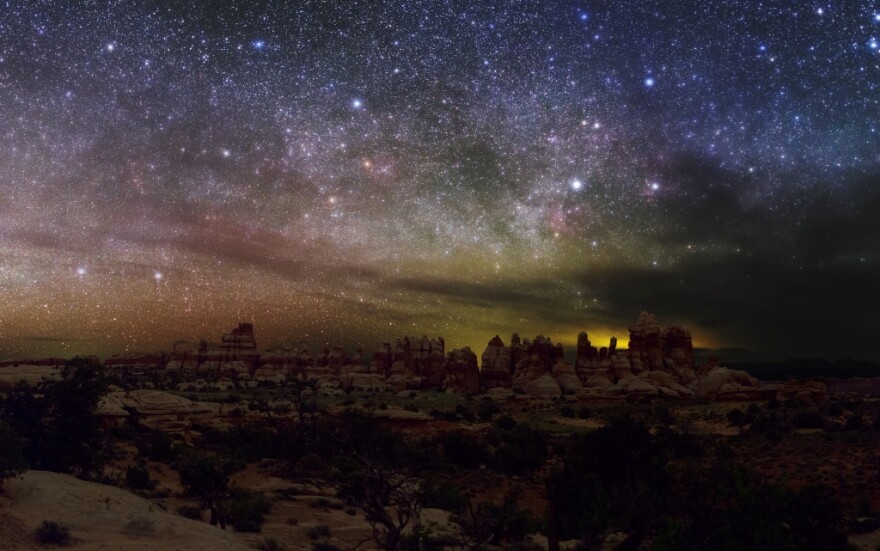Nancy Gonlin, Professor of Anthropology at Bellevue College says that “Without electrical lighting to guide the way, our ancestors in the ancient world experienced night very differently than we do today...As light pollution continues to dissipate the darkness for us modern humans—changing, for example, our perception of the stars—the urgency to document the history of human experience from dusk till dawn has never been greater.”
Paul Bogard, author of “The End of Night: Searching for Natural Darkness in an Age of Artificial Light,” spent his childhood summers in a cabin on a lake in northern Minnesota, where shooting stars cut across swaths of countless stars, the Milky Way reflected off the lake, and the woods were so dark he couldn’t see his hands in front of his face. In our modern world of nights as bright as day, most of us no longer experience true darkness. Eight out of ten Americans born today won’t ever live where they can see the Milky Way. Bogard believes we should re-inhabit the darkness.
Paul Bogard is the author of The End of Night: Searching for Natural Darkness in an Age of Artificial Light, published in North America by Little, Brown, and in the UK and around the world by 4th Estate/Harper Collins. The book has been translated into German, Spanish, Japanese, Chinese, and Korean.The End of Night is available in hardcover, e-book, paperback, and audiobook. His new book, The Ground: the Life, Death, and Future Beneath Our Feet, will be published by Little, Brown in 2017. Paul is also editor of the anthology Let There Be Night: Testimony on Behalf of the Dark, a collection of essays by twenty-eight wonderful writers on the value of darkness and the costs of light pollution. His writing has appeared in print and online in Slate, Salon, Los Angeles Times, Outside, Audubon, Conservation, Reader's Digest, National Geographic, Creative Nonfiction, and elsewhere.
Dr. Christine Dixon Chris Dixon studied Classic Period Maya agricultural production and organization. She feels very fortunate to have worked at the Cerén site in El Salvador since 2005 with her dissertation advisor, Payson Sheets. Dixon’s research at the site focused on geophysical investigations and excavation of agricultural fields and the recent find of the Cerén sacbe (road). She also participated in archaeological projects Belize, Honduras, Mexico and Hawaii.
Adam Block's life-long goal to be an astronomer began at the early age of 4. He specifically selected the University of Arizona to continue his pursuits and graduated with a B.S. in Astronomy and Physics in 1996. He spent the next nine years developing and administering public outreach programs at the National Observatory (Kitt Peak). Since 2007 his dream to create foremost public outreach experiences in astronomy is being realized with a return to the University under Steward Observatory and the College of Science at the Mount Lemmon SkyCenter. Adam is most well-known for his abilities to speak and communicate difficult concepts in astronomy in simple and creative ways. Over the past 15+ years he has hosted many thousands of evenings for the public and strives to maintain quality programs that are fresh and exciting with unflagging enthusiasm. Adam is also recognized around the world as a leading astrophotographer. The images he produces as part of public outreach programs are published in magazines, books, posters, and widely on the internet. His images have graced NASA's "Astronomy Picture of the Day" website more than 70 times and have been used as reference images by amateur and professional astronomers alike. In 2012 he was the recipient of the "Hubble Award" from the Advanced Imaging Conference- one of the highest awards for work in astrophotography that is recognized around the world.
John Barentine, International Dark-Sky Association, is an Arizona native and comes to IDA from the “dark side” of science — professional astronomy. He grew up in Phoenix and was involved in amateur astronomy there from grade school. Later, he attended the University of Arizona, beginning research in jobs at the National Optical Astronomy Observatories and National Solar Observatory headquarters in Tucson. From 2001-06 he was on the staff of Apache Point Observatory in New Mexico, serving first as an observing specialist on the Astrophysical Research Consortium 3.5-meter telescope and then as an observer for the Sloan Digital Sky Survey.He obtained a master’s degree in physics at Colorado State University and a master’s and Ph.D. in astronomy at the University of Texas at Austin. John has contributed to science in fields ranging from solar physics to galaxy evolution while helping develop hardware for ground-based and aircraft-borne astronomy. Throughout his career, he has been involved in education and outreach efforts to help increase the public understanding of science. The asteroid (14505) Barentine is named in his honor. His interests outside of astronomy and dark skies include history, art/architecture, politics, law and current events.
Pete Strasser, International Dark-Sky Association, has been an astral photographer since age five. Pete Strasser has long been interested in the practical and aesthetic effects of light. His degree in plant pathology from the University of California, Davis, imparted detailed insight in the composition and effects of different light sources. This knowledge proved invaluable during his work as IDA’s Technical Advisor and then Technical Director from 2006-2011. After a five-year hiatus, Pete returned to his position in 2016 as the IDA Technical Director.



